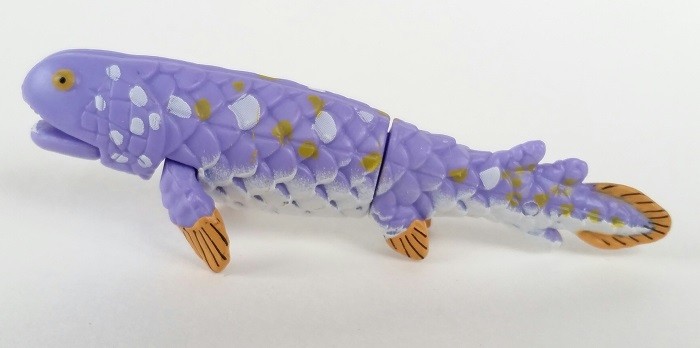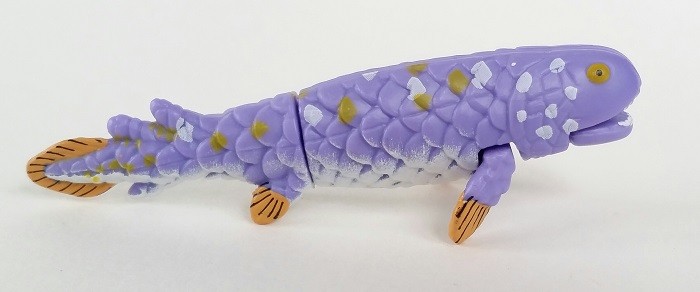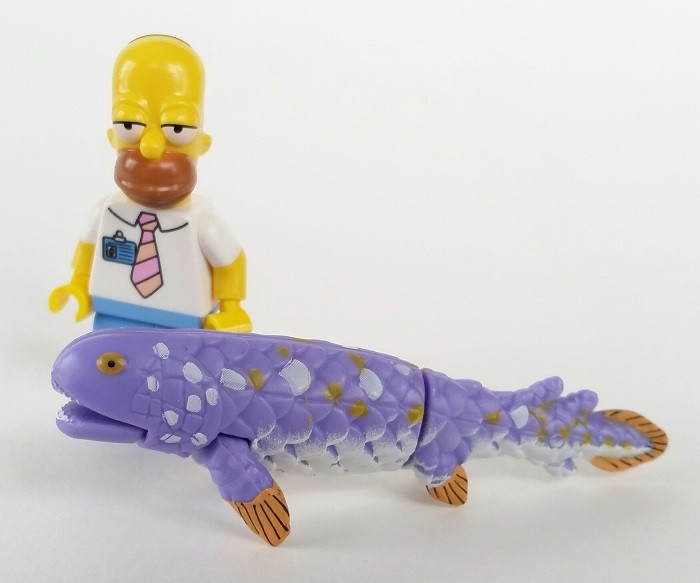Review and photographs by Tim Sosa
Yowie is a Perth-based company that markets nature-themed toys in little chocolate eggs. These days they have some extant animals that you can buy at places like World Market (at least in the United States), but around a decade ago they had an Australia-only line of prehistoric figures called Lost Kingdoms. The majority of the figures were Australian animals, and many remain the only toy example of their respective species. There were 110 basic figures in all, and since Australia has a very rich fossil record from both the Paleozoic and the Cenozoic, but a pretty spotty record in the Mesozoic, there was heavy emphasis on prehistoric mammals, as well as more than a few pre-dinosaur animals. Today’s review concerns an animal that lived long before the dinosaurs, in the early Carboniferous (330-345 million years ago): the “Ducabrook Rhizodont.”

Yowie figures include small paper inserts with photos or artwork, and for some of the Lost Kingdoms figures, the proper scientific name is also included. For the “Ducabrook Rhizodont,” however, the only taxonomy specified is the Rhizodontida, a formerly diverse group of predatory fishes closely related to the tetrapods. In 2000 and 2005, teeth, jaw fragments, and shoulder girdle elements were described based on specimens from the Ducabrook formation in Queensland. The remains were assigned to the genus Strepsodus (Gr. “twisted tooth”), which is also known from places as distant as North America, reflecting the very different geography of Earth in the Carboniferous. This is probably the genus the toy is based on.

The Ducabrook Rhizodont figure is a little over 7 cm long, making it about 1:40 scale. It’s heavily stylized, but deceptively detailed, with individually sculpted scales, grooves in the dermal bones of the face, and a slightly movable jaw. It has an unusual lavender color scheme, with white and yellow spots. There’s a streak of white painted over the row of teeth in the edges of the mouth. Rhizodonts also had teeth all over the roof of the mouth, including huge tusks, but there’s no sign of the death-trap maw here.

The fins are all present and in approximately the correct positions: the two dorsal fins and the anal fin are small and placed far back, and the pectoral fins are nice and broad. The fins have fleshy bases, reflecting the fact that rhizodonts were related to both coelacanths and other sarcopterygians like our own ancestors.

Overall, if you want a rhizodont figure, your options are few. Luckily, despite looking a little cartoony, this toy is a reasonable representation. It’s a little hard to find now, having been out of production for several years and only having been sold in Australia. But occasionally it and other Yowie figures turn up on eBay and other secondary market sites. If you’re interested in life before the dinosaurs, it’s worth seeking out.
PS: If anyone is interested, the description of the Ducabrook remains is in:
Johanson Z, Turner S, Warren A, 2000. Geodiversitas 22: 161-169
Support the Dinosaur Toy Blog by making dino-purchases through these links to Ebay and Amazon. Disclaimer: links to Ebay.com and Amazon.com on the Dinosaur Toy Blog are often affiliate links, when you make purchases through these links we may make a commission

There are some Yowie figures available on eBay. I was planning for that.